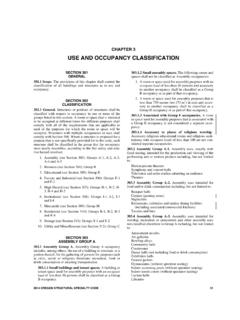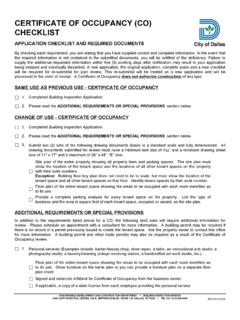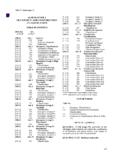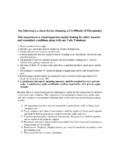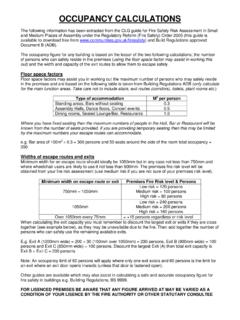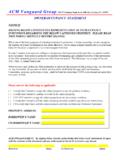Transcription of CHAPTER 3. ELIGIBILITY FOR ASSISTANCE AND …
1 HUD occupancy Handbook 3-1 6/07 CHAPTER 3: ELIGIBILITY for ASSISTANCE and occupancy REV-1 CHAPTER 3. ELIGIBILITY FOR ASSISTANCE AND occupancy 3-1 Introduction A. This CHAPTER discusses the requirements and procedures for determining whether applicant families may participate in HUD-subsidized multifamily housing programs. Described in this CHAPTER are steps an owner must follow to determine whether a family is eligible to receive ASSISTANCE in a HUD-subsidized multifamily property and eligible to live in a specific property and unit. These activities are described in a sequential order; however, owners may deviate from this sequence based on project circumstances as long as they determine an applicant s ELIGIBILITY before admitting the family to the property.
2 1. While this CHAPTER provides the rules for ELIGIBILITY , the processes for developing and maintaining a waiting list and correctly selecting an applicant for the next available unit are addressed in CHAPTER 4, Sections 3 and 4. Determining and verifying annual income, which is an ELIGIBILITY requirement, is addressed in CHAPTER 5. 2. Subsequent chapters in the handbook address activities that occur once an owner determines that a family is eligible for tenancy, such as leasing, recertification, terminations, billing, and reporting. B. This CHAPTER is divided into three sections, each of which identifies the variations in ELIGIBILITY requirements based upon type of subsidy.
3 The three sections are as follows: Section 1: Program ELIGIBILITY , which describes the criteria by which the owner must determine whether a family is eligible to receive ASSISTANCE ; Section 2: Project ELIGIBILITY , which describes the criteria by which the owner must determine whether a family is eligible to reside in a specific property ( , project ELIGIBILITY limited to a specific population, unit size, and occupancy standards); and Section 3: Verification of ELIGIBILITY Factors, which describes how the owner should collect information to document family composition, disability status, social security numbers, and other factors affecting ELIGIBILITY for ASSISTANCE .
4 HUD occupancy Handbook 3-2 6/07 CHAPTER 3: ELIGIBILITY for ASSISTANCE and occupancy REV-1 3-2 Key Terms A. There are a number of technical terms used in this CHAPTER that have very specific definitions established by federal statute or regulations or by HUD. These terms are listed in Figure 3-1 and their definitions can be found in the Glossary to this handbook. It is important to be familiar with these definitions when reading this CHAPTER . B. The terms disability and persons with disabilities are used in two contexts for civil rights protections, and for program ELIGIBILITY purposes.
5 Each use has specific definitions. 1. When used in context of protection from discrimination or improving the accessibility of housing, the civil rights-related definitions apply. 2. When used in the context of ELIGIBILITY under multifamily subsidized housing programs, the program ELIGIBILITY definitions apply. NOTE: See the Glossary for specific definitions and paragraph 2-23 for an explanation of this difference. Figure 3-1: Key Terms Applicant ASSISTANCE animals Chronically mentally ill Citizen Developmentally disabled Disabled family Disabled household Displaced family Elderly family Elderly person Eligible noncitizen Evidence of citizenship or eligible status Family Income limit * Independent student * Live-in aide Mixed family National Near-elderly family Noncitizen Nonelderly disabled family PAC (Project)
6 ASSISTANCE Contract) Person with disabilities Physical disability PRAC (Project Rental ASSISTANCE Contract) Prorated ASSISTANCE RAP (Rental ASSISTANCE Payment) Remaining member of a tenant family Rent Supplement Section 8 Section 1: Program ELIGIBILITY HUD occupancy Handbook 3-3 06/09 CHAPTER 3: ELIGIBILITY for ASSISTANCE and occupancy REV-1 CHG-3 Section 1: Program ELIGIBILITY 3-3 Key Regulations This paragraph identifies key regulatory citations pertaining to Section 1: Program ELIGIBILITY .
7 The citations and their titles (or topics) are listed below. A. Income Limits 24 CFR , and (Annual income and income ELIGIBILITY ) B. Disclosure of Social Security Numbers 24 CFR Disclosure and Verification of Social Security and Employer Identification Numbers C. Consent Forms 24 CFR , (Consent by applicants and assisted participants and penalties for failing to sign consent forms) D. Restrictions on ASSISTANCE to Noncitizens 24 CFR part 5, subpart E Restrictions on ASSISTANCE to Noncitizens E. Restrictions on ELIGIBILITY of Students for Section 8 ASSISTANCE 24 CFR Restrictions on ASSISTANCE to students enrolled at an institution of higher education.
8 3-4 ELIGIBILITY Determinations General Owners are required to determine whether applicants are eligible to occupy the subsidized property and receive housing ASSISTANCE . ELIGIBILITY is determined by federal statute and HUD regulation. For HUD programs, ELIGIBILITY is only determined at move-in or at initial certification except as discussed in paragraphs *3-13, Determining ELIGIBILITY of Students for ASSISTANCE * and 3-16, Determining the ELIGIBILITY of a Remaining Member of a Tenant Family. HUD's general ELIGIBILITY requirements are found in HUD's regulations at 24 CFR, part 5.
9 3-5 Key Program ELIGIBILITY Requirements Applicants and tenants must meet the following requirements to be eligible for occupancy and housing ASSISTANCE . Subsequent paragraphs provide more detailed information about income limits, social security numbers, and consent forms. Section 1: Program ELIGIBILITY HUD occupancy Handbook 3-4 6/07 CHAPTER 3: ELIGIBILITY for ASSISTANCE and occupancy REV-1 A. The family s annual income must not exceed program income limits. B. Applicants must disclose social security numbers for all family members at least 6 years of age and older and provide proof of the numbers reported.
10 C. All adults in each applicant family must sign an Authorization for Release of Information prior to receiving ASSISTANCE and annually thereafter. D. The unit for which the family is applying must be the family s only residence. E. An applicant must agree to pay the rent required by the program under which the applicant will receive ASSISTANCE . F. Only citizens or eligible noncitizens may receive ASSISTANCE under Section 8, Section 236, Rent Supplement, Rental ASSISTANCE Payment (RAP), and Section 202/8 programs. G. All information reported by the family is subject to verification.











